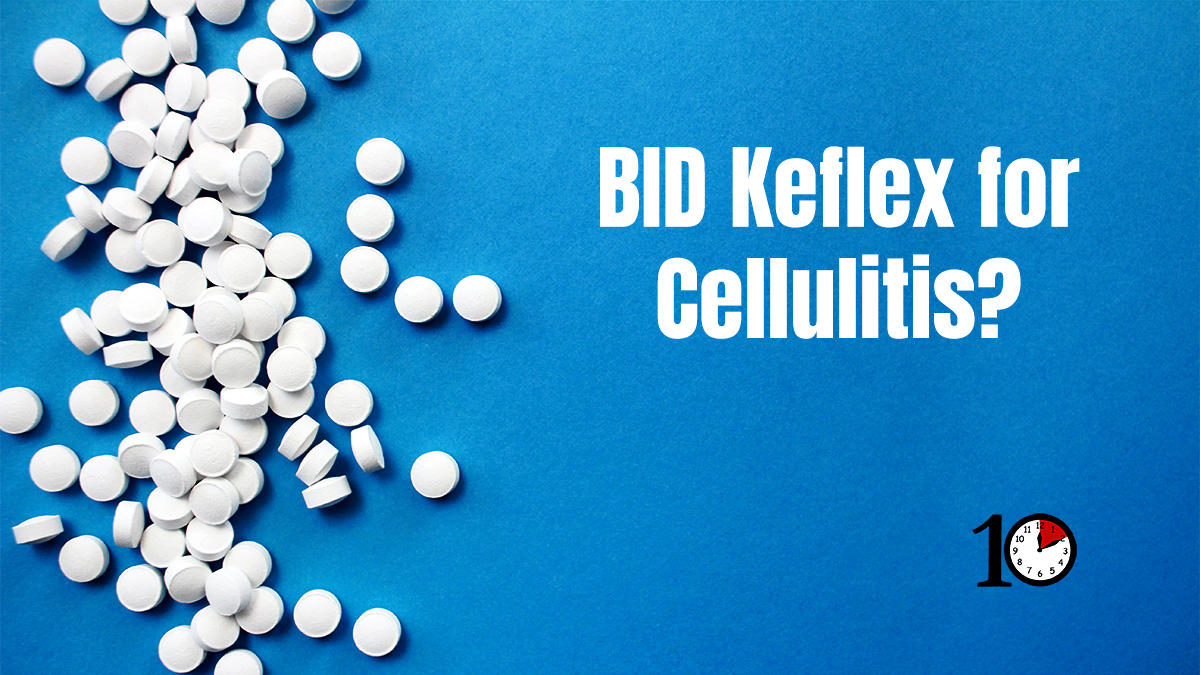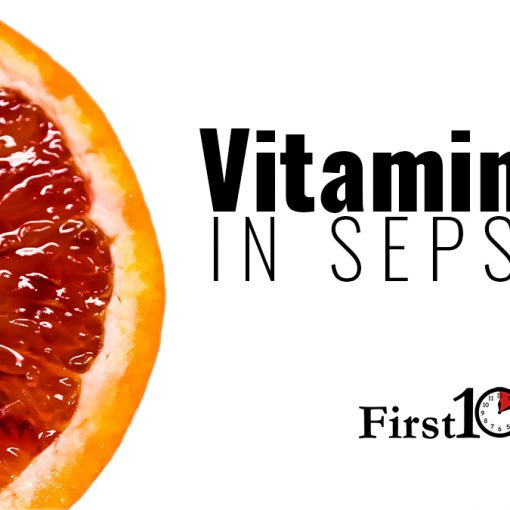Zhou, J. Is QID dosing necessary for cephalexin?, First10EM, June 13, 2022. Available at:
https://doi.org/10.51684/FIRS.128028

This is a guest post by Dr. Jason Zhou. Jason is a first-year Family Medicine resident at the University of Toronto. He grew up in Burnaby and attended UBC for his Bachelor’s of Science before moving to Toronto for medical school. Jason enjoys playing sports in his leisure time and spends his days off snowboarding.
I was nearing the end of my evening shift when a patient I had treated three days prior returned with worsening arm pain and redness. Previously, I had prescribed her Keflex 500 mg QID (four times daily) for a simple case of cellulitis. Upon speaking with the patient, I found she had forgotten to bring the antibiotics to work and missed a few doses. After reevaluating her skin and ruling out further complications, I prescribed TMP/SMX DS 1 tab BID (twice daily) in addition to Keflex to cover for MRSA. I further emphasized the significance of treatment adherence in order to prevent any deterioration of her symptoms. She begrudgingly agreed but remarked, “twice a day on top of four times a day, that’s a lot to remember.” I agreed. Studies indicate that drug compliance decreases as dose frequency increases. A systematic review of 76 trials revealed, for instance, that compliance fell from 69 percent with BID dosing to 51 percent with QID dosing (Claxton et al., 2001). This got me thinking: Is there anything we can do to simplify the dosage of cellulitis treatments?
Question
Is BID dosing of cephalexin, compared to QID, non-inferior/equally effective at treating uncomplicated cellulitis?
Uncomplicated cellulitis: skin and skin structure infections with no purulent drainage or exudate, no associated abscess, and no risk factors for MRSA. In this case, the patient can be safety discharged home with course of oral antibiotics
Current practice guidelines
According to UpToDate, the recommended treatment for uncomplicated cellulitis is cephalexin 500mg PO QID for 5 days, with an option to extend treatment up to 14 days if the infection has not improved (Spelman & Baddour, 2021). This aligns with our regional guidelines in Toronto – Sinai Health Systems + University Health Network’s Antimicrobial Stewardship Guide – as well as guidelines from the Canadian and American Family Medicine Colleges (Kosar & Laubscher, 2017; Ramakrishnan et al., 2015; Sinai Health Systems & University Hospital Network, 2020).
Nearly every guideline or reference source quotes four times daily dosing. That’s four times a day! How challenging is it to get patients to take daily medications, let alone something dosed four times a day? I’m skeptical of the feasibility of this dosing regimen. Are my patients skipping dosages or discontinuing treatment?
Why do we need antibiotics?
Assume the worst case scenario: patients miss doses due to QID dosage. Would that be harmful? What evidence do we have for treating cellulitis with antibiotics? A systematic review comparing cellulitis and erysipelas cure rates before and after the introduction of antibiotics found increased cure rates from 66% without antibiotics to 98% for penicillin-treated patients, with penicillin reducing mortality by 10% (Spellberg et al., 2009). That’s impressive, so we should do everything we can to assist our patients in taking their antibiotics. Justin’s comment: Can you imagine working in an era where cellulitis had more than a 10% mortality rate. Obviously, these results may not perfectly extrapolate to modern practice.
What’s the best agent?
According to a Cochrane analysis of 25 RCTs published in 2010, there is no obvious antibiotic of choice (Kilburn et al., 2010). Each RCT examined two or more distinct cellulitis therapies, though no two trials looked at the same antibiotics and no conventional treatment regimen was used as a comparator. Penicillins, cephalosporins, macrolides, and quinolones are among the antibiotic classes compared. There was also no discernible difference in treatment between oral and intravenous antibiotics.
What’s the optimal duration of treatment?
A study by Hepburn et al found that patients on a short-course (5 days) and a standard-course (10 days) of levofloxacin for uncomplicated cellulitis had similar outcomes (Hepburn et al., 2004). This presumably formed the basis for shortened courses of other antibiotics.
QIB vs BID: The Evidence
Only one RCT compared cephalexin QID to cephalexin BID (Dimattia et al., 1981). The study involved 154 patients in four clinics, ranging in age from one month to 70 years. Patients were randomly assigned to receive either cephalexin 500mg twice daily or cephalexin 250mg four times a day. Both arms received the same combined daily dose of 1g of cephalexin, which is only half of the standard 2g daily dose of cephalexin we use now. Justin’s comment: I actually frequently prescribe Keflex at 1g QID, which was the dosing used in Aboltins 2015.
The study measured both clinical and bacteriologic outcomes to determine treatment success. Clinical success was defined as an improvement in cellulitis symptoms, while bacteriologic cure was defined as repeated negative cultures. Both BID and QID dosing proved to be equally effective. The study also monitored adverse effects and found no difference in reported side effects between the two groups. Justin’s comment: Prior to reading the Aboltins 2015 paper, I routinely prescribed Kelfex as 1 gram BID rather than 500mg QID. I can no longer remember where that recommendation came from, but I believe it was based on an evidence review done by the Best Science Medicine podcast.
Bottom line
Cellulitis is a frequent presentation in the ED. There’s insufficient evidence to guide us in choosing one antibiotic over another, so most choices of penicillins, cephalosporins, macrolides, or quinolones will suffice. (However, much of this evidence comes from an era before MRSA, so local resistance patterns should always be considered.) There’s minimal evidence to answer my initial question: is BID dosing as effective as QID? However, the single study available suggests equivalence. Therefore, for simplicity and ease of use, I will offer my patients 1g BID cephalexin x 5 days for the treatment of uncomplicated cellulitis.
PS
There’s talk of using cefadroxil 1g oral once daily instead of cephalexin, further simplifying cellulitis treatment from twice daily to once daily. This was recommended by Dr Isaac Bogach at the recent North York General Emergency Medicine Update conference. Cefadroxil is a longer lasting derivative of cephalexin and is similarly a first generation cephalosporin and has identical microbial coverage (Lexicomp, n.d.); hence, it’s a plausible explanation, despite the lack of clinical data.
References
Aboltins CA, Hutchinson AF, Sinnappu RN. Oral versus parenteral antimicrobials for the treatment of cellulitis: a randomized non-inferiority trial. The Journal of antimicrobial chemotherapy. 2015; 70(2):581-6. PMID: 25336165
Claxton, A. J., Cramer, J., & Pierce, C. (2001). A Systematic Review of the Associations Between Dose Regimens and Medication Compliance (Vol. 23, Issue 8).
Dimattia, A. F., Sexton, M. J., Smialowicz, C. R., Knapp, W. H., Diego, S., Alifornia, C., Jersey, N., & Orvallis, C. (1981). Efficacy of Two Dosage Schedules of Cephalexin in Dermatologic Infections. In THE JOURNAL OF FAMILY PRACTICE (Vol. 12, Issue 4).
Hepburn, M. J., Dooley, D. P., Skidmore, P. J., Ellis, M. W., Starnes, W. F., & Hasewinkle, W. C. (2004). Comparison of short-course (5 days) and standard (10 days) treatment for uncomplicated cellulitis. Archives of Internal Medicine, 164(15), 1669–1674. https://doi.org/10.1001/archinte.164.15.1669
Kilburn, S. A., Featherstone, P., Higgins, B., & Brindle, R. (2010). Interventions for cellulitis and erysipelas. In Cochrane Database of Systematic Reviews (Vol. 2020, Issue 12). John Wiley and Sons Ltd. https://doi.org/10.1002/14651858.CD004299.pub2
Kosar, L., & Laubscher, T. (2017). Management of impetigo and cellulitis. Canadian Family Physician, 63(8), 615–618. https://www.cfp.ca/content/63/8/615
Lexicomp. (n.d.). Cefadroxil: Drug information. UpToDate. Retrieved May 11, 2022, from https://www.uptodate.com/contents/cefadroxil-drug-information
Ramakrishnan, K., Salinas, R. C., & Agudelo Higuita, N. I. (2015). Skin and Soft Tissue Infections. American Family Physician, 92(6), 474–483. http://www.ncbi.nlm.nih.gov/pubmed/26371732
Sinai Health Systems, & University Hospital Network. (2020). Skin and Skin StructureInfections (SSSIs). Antimicrobial Stewardship Program. https://www.antimicrobialstewardship.com/ssisummary
Spellberg, B., Talbot, G. H., Boucher, H. W., Bradley, J. S., Gilbert, D., Michael Scheld, W., Edwards, J., & Bartlett, J. G. (2009). Antimicrobial agents for complicated skin and skin-structure infections: Justification of noninferiority margins in the absence of placebo-controlled trials. In Clinical Infectious Diseases (Vol. 49, Issue 3, pp. 383–391). https://doi.org/10.1086/600296
Spelman, D., & Baddour, L. M. (2021, October 29). Cellulitis and skin abscess in adults: Treatment. UpToDate. https://www.uptodate.com/contents/cellulitis-and-skin-abscess-in-adults-treatment






6 thoughts on “Is QID dosing necessary for cephalexin?”
At our shop, we have been using Cefadroxil, 1 gm bid for the last few years, with excellent success. 500 mg bid was often ineffective.
It would be great if a single dose a day were equally effective.
Thanks for the comment. I have not used it yet, but based on feedback from a few colleagues, it sounds like cefadroxil is much more expensive than cephalexin where I live, which might limit my inclination to switch.
While I acknowledge the challenges to adherence, it seems irresponsible to me to recommend 1g BID over 500mg QID based on a single paper and without this article even addressing the half-life of cephalexin (~1 hour for healthy adults) and the fact that beta-lactams have time-dependent killing.
Sincerely,
A concerned ED pharmacist and long-time First10EM reader
I guess my question is what is the evidence that “time dependent killing” is a physiologic phenomenon that has clinical relevance? For the most part, I think small RCTs provide us with better clinical evidence than physiologic reasoning. From personal experience, I used 1 gram BID for almost a decade with no known complications (although obviously my follow-up, as an emergency doctor, is very far from being complete).
Half life is irrelevant as it measures elimination rate from blood not tissues, also clinical recommendations should be based on clinical evidence not on theoretical analysis.
Before I moved to Canada I always recommended BID regimen, the BNF stated QID and alternatively BID, so it’s within the acceptable recommended dose in the UK to prescribe it as BID, with no evidence suggesting treatment failure.